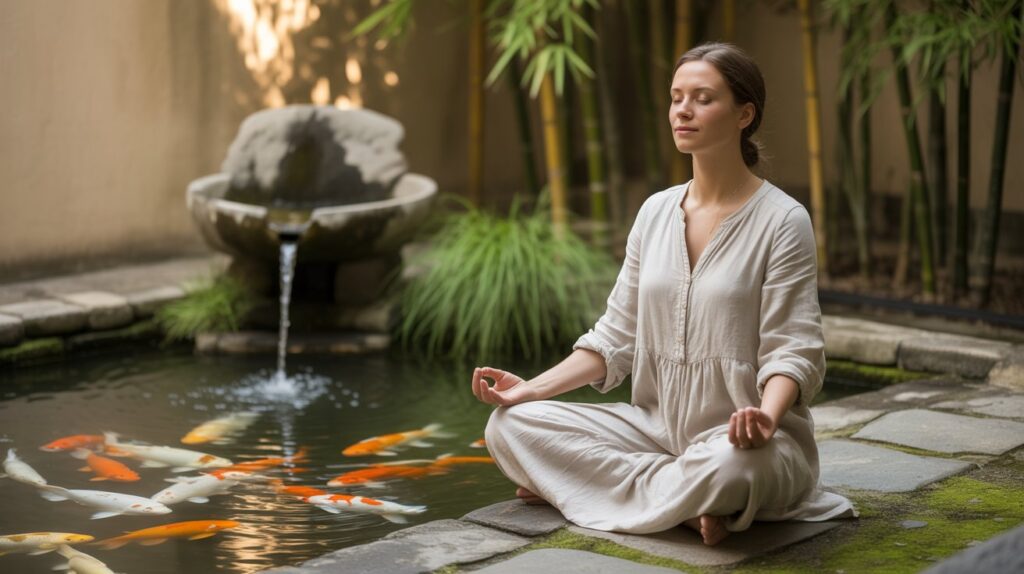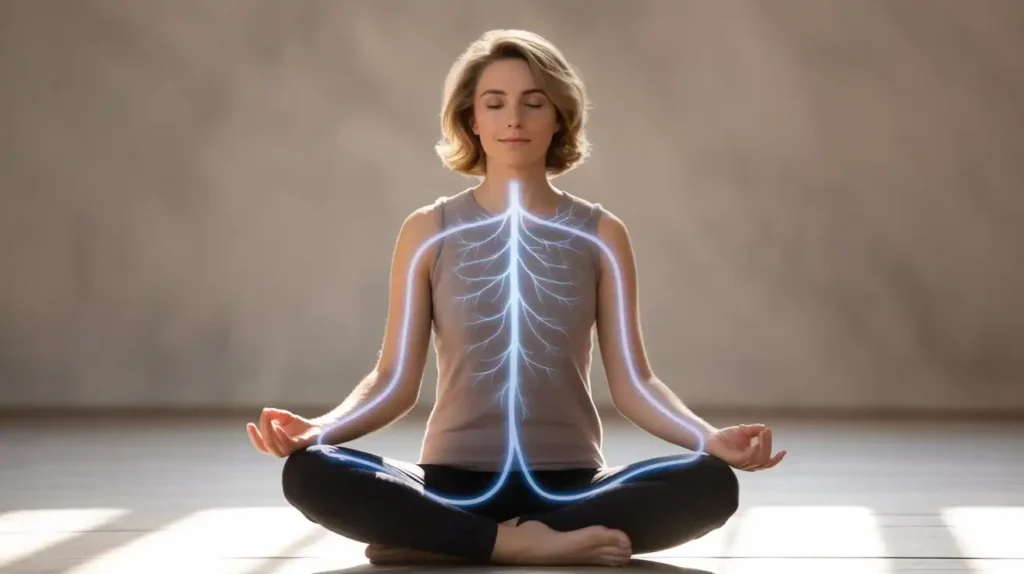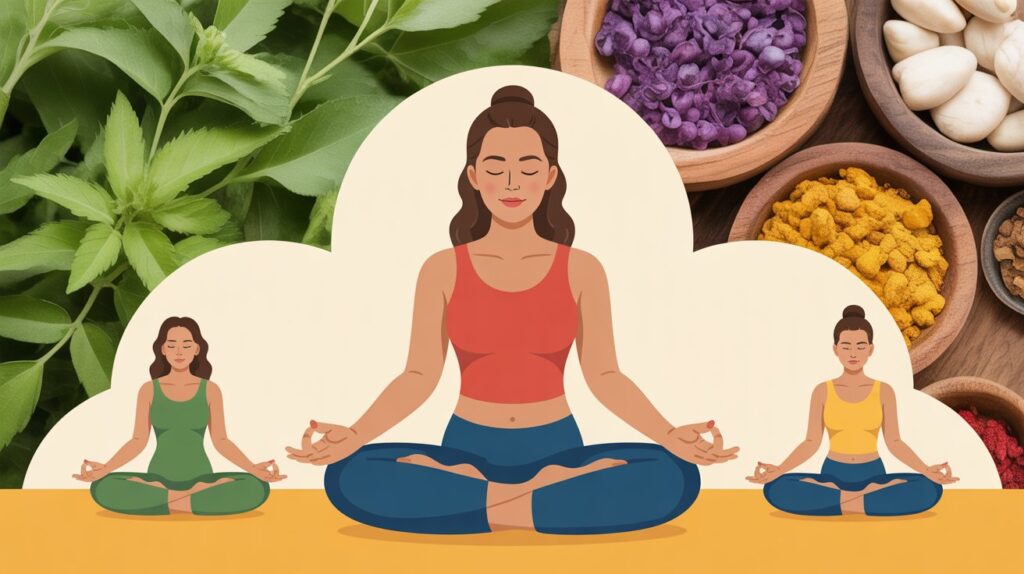Simple meditation practices help reduce stress, improve focus, and build emotional balance without special equipment or long time commitments. The steps below are designed for 5–15 minute sessions that can fit into a busy day while still producing noticeable benefits.
What is meditation?
Meditation is an intentional practice of placing attention on an anchor (like breath, body sensations, or phrases), noticing distractions, and gently returning, which gradually builds steadier attention and emotional balance in daily life.
Different styles share this core loop of focus, distraction, and return, so beginners can start with simple anchors and still realize meaningful benefits without complex techniques or long sessions.
How to use this guide
- Pick one practice and repeat it daily for 7–10 days at 5–10 minutes to build consistency, then extend to 10–15 minutes if helpful for routine and depth.
- Sit comfortably and alert, or try walking if drowsy; the best practice is the one done reliably, so choose the form that supports adherence today.
SiMple Meditation practices
1. Focused breath meditation
The breath is a universal anchor—portable, natural, and always available—making it ideal for busy schedules and quick resets between tasks or at bedtime.
Practice along
- Minute 0–1: Arrive, feel the contact of feet, seat, and hands, and let one slower exhale soften the jaw and shoulders to settle attention gently.
- Minute 1–3: Choose the anchor—nostrils (cool in, warm out) or belly (rise, fall)—and silently label “in… out…” to stabilize awareness without forcing the breath.
- Minute 3–4: When the mind wanders, note “thinking,” “hearing,” or “feeling,” and kindly return to the anchor, treating the return as the core repetition of the practice.
- Minute 4–5: Drop labels and rest with raw breath sensations, noticing any shift in calm or clarity before opening the eyes and committing to the next session.
Variations and fixes
- Box breathing 4–4–4–4 for steadiness or 4–7–8 to wind down, and if drowsy, sit taller and crack the eyes slightly to maintain wakefulness without tension. In box breathing, inhale for 4 counts, hold for 4, exhale for 4, then hold empty for 4, repeating smoothly without strain; for 4–7–8, inhale 4, hold 7, and exhale 8, keeping the breath quiet and even.
2. Body scan meditation
A body scan cultivates interoceptive awareness and releases subtle tension by steadily observing sensations through the body without judgment or forcing change.
Practice along
- Minute 0–1: Settle and notice contact points with the chair, cushion, or floor, letting the body be supported to reduce fidgeting and unnecessary effort.
- Minute 1–3: Scan crown → face/jaw → neck/shoulders → chest/back → belly, noting temperature, pressure, tingling, or pulsing without trying to fix or improve sensations.
- Minute 3–5: Scan pelvis/hips → thighs/knees → calves/ankles → feet/toes, pausing for two breaths at any area that feels tense and imagining the exhale softening the tissues.
Variations and fixes
- Use a three‑zone scan (head/neck, torso, legs/feet) for a fast routine, and if overwhelmed, return to belly breathing for a few cycles before resuming the scan in larger regions.
3. Loving‑kindness meditation (metta meditation)
Metta meditation or Loving‑kindness meditation is a Buddhist Practice that cultivates goodwill and self‑compassion by silently repeating kind phrases first to oneself and then outward to others, softening harsh inner dialogue over time.
Practice along
- Minute 0–1: Self—“May I be safe, healthy, peaceful, and at ease,” choosing language that feels sincere rather than formal or forced for a more authentic tone.
- Minute 1–2: Loved one—the same phrases directed to someone whose wellbeing is easy to care about, supporting warmth and ease as emotional cues arise.
- Minute 2–3: Neutral person—someone seen often but not well known, gently widening the circle of care without requiring strong emotion or imagery.
- Minute 3–4: Difficult person—keep brief and gentle, intending goodwill without condoning actions, and honoring readiness by not pushing beyond capacity.
- Minute 4–5: All beings—extend phrases outward in all directions, allowing a sense of spacious goodwill to settle before closing the practice.
Variations and fixes
- Visualize warmth expanding from the chest when phrases feel flat, and if resistance appears with the difficult person, shorten that stage and return to self or loved one for stability.
4. Guided meditation (with or without audio)
External guidance reduces decision fatigue and supports beginners with pacing and reminders to return, and can be used on busy days while alternating with self‑guided breath or body practices.
Practice along
- Choose a short, calm session (5–10 minutes), use headphones if helpful, and follow an anchor‑based cueing style where the guide sets one anchor for the whole session (for example, “breath at the nostrils” or “belly rising and falling”) and keeps bringing attention back to that anchor whenever distraction appears. Typical cues sound like “feel the next inhale… feel the next exhale,” “notice the rise and fall of the belly,” or “return to the feeling of the breath,” so attention keeps circling back to one steady reference point instead of switching targets mid‑practice.
- If music distracts, choose voice‑only guidance; if the pace feels off, pick a track length or tempo that matches a natural breathing rhythm so the anchor and the cues feel comfortable rather than rushed.
5. Mindful walking
Walking meditation integrates mindfulness with gentle movement, making it useful when sitting feels restless or sleepy and during transitions between meetings or tasks.
Practice along
- Minute 0–1: Stand, feel both feet, and take one slower exhale to arrive, letting posture lengthen without stiffness or strain for an alert yet relaxed start.
- Minute 1–3: Walk slowly and track lift–move–place with each step, keeping attention in the soles and weight shifts to ground awareness in movement.
- Minute 3–5: When distracted, pause to feel the stance for one breath, then continue, aiming for an unhurried loop in a quiet space or corridor.
Variations and fixes
- Pair breath with steps (e.g., 3 steps inhale, 4 steps exhale), and if self‑conscious outdoors, walk at a normal pace while attending to footfalls and contact points.
6. Humming meditation (Brahmari)
Humming meditation uses a gentle “hmm” sound on the exhale to create soothing vibrations that can downshift arousal and ease mental chatter, making it a practical reset before seated practice or bedtime.

Practice along
- Minute 0–1: Sit comfortably with an upright, relaxed spine; soften the jaw and face; keep the mouth closed; optionally rest index fingers lightly on the ear cartilage to reduce external noise and amplify the sound of humming.
- Minute 1–3: Inhale through the nose; on the exhale, hum a steady, comfortable “hmmmm” from the back of the throat with lips closed, feeling vibration in the face and chest; keep the tone and volume soft and even.
- Minute 3–5: Continue for 4–6 rounds, letting exhalations be slightly longer than inhales; rest quietly for one breath between rounds and notice residual vibrations and calm before the next hum.
Tips and variations
- If ears are sensitive, skip ear occlusion and simply focus on the sensation of vibration; if the throat feels scratchy, reduce volume and keep the jaw soft to avoid strain.
- For a silent variant, imagine the hum and its vibration on the exhale without making sound, useful in shared spaces or when the voice is tired.
When to use
- As a 2–5 minute wind‑down before sleep, a pre‑meditation settle, or a quick midday reset to curb overthinking; many find the audible vibration helps attention “lock in” faster than silent breath alone.
Precautions
- Keep humming gentle and pain‑free; those with acute ear, sinus, or throat conditions should practice softly or pause and resume after recovery; discontinue if dizziness occurs and return to normal breathing.
7. Yoga Nidra meditation (yogic sleep)
Yoga Nidra is a guided, lying‑down practice that rotates attention through the body, breath, and imagery to induce deep relaxation while remaining aware; it’s excellent for rest, stress reduction, and pre‑sleep wind‑down.
Practice along
- Minute 0–1: Lie in shavasana, legs and arms relaxed, palms up; set a gentle intention (sankalpa) in one short phrase like “I am calm.”
- Minute 1–3: Bring awareness to natural breathing; then rotate attention systematically through the body (right hand to arm; left side; back; front), noticing sensations without changing them.
- Minute 3–5: Visualize simple calming images (light, lake, night sky); reaffirm the intention; gently deepen the breath and open the eyes.
Tips and fixes
Use a thin pillow under knees if low‑back tension arises; if sleepiness is strong, practice earlier in the day or with eyes slightly open.
8. Counting meditation (breath counting)
Counting the breath is a beginner‑friendly focus method that pairs breath sensations with numbers to steady attention and detect distraction quickly.
Practice along
- Count inhale “1,” exhale “2,” up to “10,” then start from “1” again; if distraction breaks the count, restart kindly at “1” without self‑criticism.
- Alternatives: count only exhales 1→10; or up to 8 and back down to 1 for more attentional demand; keep breathing natural and smooth.
Tips and fixes
If breath feels shallow/forced, drop counting for 3 cycles to re‑settle with natural breath, then resume; keep posture comfortable and alert.
9. Mantra meditation
Mantra meditation uses a short word or phrase repeated aloud, whispered, then silently to occupy attention and settle the mind’s verbal stream; choose an uplifting, neutral phrase that feels sincere.
Practice along
- Minute 0–1: Sit comfortably, take a few easy breaths, and set a simple intention (e.g., steadiness or ease).
- Minute 1–3: Repeat the mantra slowly with the breath—out loud for several rounds, then whispered; align repetition with inhale/exhale or repeat on both phases.
- Minute 3–5: Shift to silent repetition; when distracted, gently return to the mantra; close with two easy breaths and sit quietly before moving.
Tips and fixes
If the mantra triggers associations, switch to a simpler sound (e.g., “Om” or “So‑Hum”); let rhythm be natural rather than rigidly timed.

10‑minute CALM stack
Use this compact routine to anchor a daily habit that’s easy to repeat: Choose an anchor, Add a timer, Label distractions gently, and Map benefits at the end by naming any shift felt now.
- C — Choose breath, body, or kindness, matching the day’s needs, like steadiness for focus days or warmth for emotionally heavy days to align practice with context.
- A — Add 5–10 minutes, with a soft end bell or visual timer, to remove uncertainty while avoiding jarring alarms that can break calm abruptly.
- L — Label distractions like “thinking,” “hearing,” or “feeling,” then return, treating each return as a successful repetition of the core skill rather than a failure.
- M — Map benefits by naming sensations or mood shifts, reinforcing reward memory and increasing the likelihood of tomorrow’s practice with minimal friction.
Make it stick
Link practice to an existing routine (after brushing teeth, before opening email, post‑lunch) to reduce decision load and boost follow‑through without relying on motivation spikes.
Keep a one‑line reflection—“After practice, I feel…”—to encode the reward and track small gains, which helps maintain momentum through normal ups and downs in attention.
Quick FAQs
- What if the mind won’t quiet? -The practice is noticing wandering and returning, so the “rep” is the gentle return, not holding a blank mind, which builds skill session by session.
- How long until benefits? -Many notice calmer reactivity within 1–2 weeks of daily 5–10 minute sessions, with depth and stability continuing to grow with consistent practice.
- Is posture critical? -Comfort and wakefulness matter most, so a chair is fine; if sleepy, try eyes‑open or switch to mindful walking and return to sitting when alert.
7‑day starter plan
- Day 1–2: Breath focus 5–8 minutes with “in… out…” labels, then rest without labels for the final minute to experience raw sensation more clearly.
- Day 3–4: Body scan 8–10 minutes, breathing “through” any tight spots on the exhale and returning to the sequence if attention drifts to planning.
- Day 5: Loving‑kindness 8–10 minutes through self → loved one → neutral → difficult person → all beings at a gentle, sincere pace without forcing emotion.
- Day 6: Mindful walking 8–10 minutes with lift–move–place attention and brief pauses to reset when distracted, prioritizing an unhurried rhythm.
- Day 7: Guided 10–12 minutes, selecting a track that matches the day’s goal, then reflecting one line on any shift in body or mood after completion.
Keep the routine light and repeatable, favoring 5–10 minutes over occasional long sits; when motivation dips, return to one anchor, one breath, and begin again. Over weeks, the quiet gains add up—calmer reactivity, better focus, and a more spacious mind that’s available when it matters most.
Meditation is a simple, accessible tool that anyone can use to reduce stress, improve focus, and cultivate calm—no special equipment or experience needed. By committing to just a few minutes a day with a selected anchor practice, the mind gradually rewires for greater ease and presence in everyday life. Remember, consistency is more important than duration or “perfect” technique—warmly accept distractions, return your attention gently, and let each practice build toward a more balanced, peaceful you.
Medical Evidence Supporting Meditation Practices
Extensive research shows that simple meditation techniques offer measurable health benefits. Mindfulness meditation has been shown in meta-analyses to reduce cortisol levels and perceived stress, helping regulate the body’s stress response system.1 Randomized controlled trials demonstrate meaningful reductions in anxiety and depressive symptoms, sometimes comparable to cognitive behavioral therapy.2 Cognitive benefits include improved attention, working memory, and executive function after regular practice, supported by neuroimaging studies showing changes in brain areas linked to emotion regulation and self-awareness.3
Breathing-focused practices like box breathing and humming meditation activate the parasympathetic nervous system, increasing heart rate variability and promoting relaxation, as documented in physiological studies.4,5 Yoga Nidra and mindful breathing exercises also improve sleep quality in clinical populations with insomnia.6,7
Because meditation carries low risk and is easily accessible, it serves as a valuable complementary tool across diverse populations aiming for enhanced mental well-being and stress resilience, with growing evidence supporting safety and adaptability.
Footnotes
- Koncz, A., Demetrovics, Z., & Takacs, Z. K. (2020). Meditation interventions efficiently reduce cortisol levels of at-risk samples: a meta-analysis. Health Psychology Review, 15(1), 56–84. https://doi.org/10.1080/17437199.2020.1760727 https://www.tandfonline.com/doi/full/10.1080/17437199.2020.1760727
- Komariah M, Ibrahim K, Pahria T, Rahayuwati L, Somantri I. Effect of Mindfulness Breathing Meditation on Depression, Anxiety, and Stress: A Randomized Controlled Trial among University Students. Healthcare (Basel). 2022 Dec 22;11(1):26. doi: 10.3390/healthcare11010026. PMID: 36611488; PMCID: PMC9819153. https://pmc.ncbi.nlm.nih.gov/articles/PMC9819153/
- Calderone A, Lo Buono V, Russo M, et al. Neurobiological Changes Induced by Mindfulness and Meditation: A Systematic Review. Brain Sci. 2024;14(1):45.
https://www.ncbi.nlm.nih.gov/pmc/articles/PMC11591838/ - Russo MA, Santarelli DM, O’Rourke D. The physiological effects of slow breathing in the healthy human. Breathe (Sheff). 2017;13(4):298-309. https://www.ncbi.nlm.nih.gov/pmc/articles/PMC5731770/
- Trivedi G, Sharma K, Saboo B, Kathirvel S, Konat A, Zapadia V, Prajapati PJ, Benani U, Patel K, Shah S. Humming (Simple Bhramari Pranayama) as a Stress Buster: A Holter-Based Study to Analyze Heart Rate Variability (HRV) Parameters During Bhramari, Physical Activity, Emotional Stress, and Sleep. Cureus. 2023 Apr 13;15(4):e37527. doi: 10.7759/cureus.37527. PMID: 37193427; PMCID: PMC10182780. https://pmc.ncbi.nlm.nih.gov/articles/PMC10182780/
- Jerath R, Crawford M, Barnes VA, Harden K. Self-regulation of breathing as an adjunctive treatment of insomnia. Front Psychiatry. 2019;10:683. https://www.ncbi.nlm.nih.gov/pmc/articles/PMC6719087/
- Sharpe E, Tibbitts D, Wolfe B, Senders A, Bradley R. Qualitative Impressions of a Yoga Nidra Practice for Insomnia: An Exploratory Mixed-Methods Design. J Altern Complement Med. 2021 Oct;27(10):884-892. doi: 10.1089/acm.2021.0125. Epub 2021 Jul 15. PMID: 34265219; PMCID: PMC10772320. https://pmc.ncbi.nlm.nih.gov/articles/PMC10772320/












